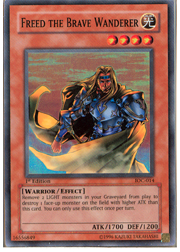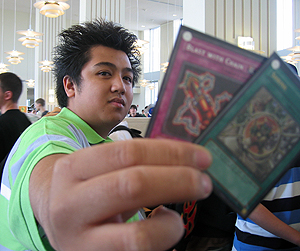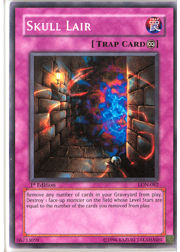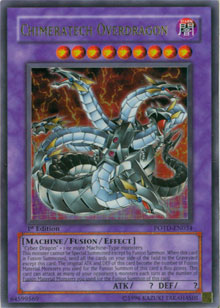
The first Shonen Jump Championship of the new format has come and gone, and we’ve been left with more questions than answers. Boston was filled with all sorts of new and interesting decks, and this week I’d like to take a look at some of them, as well as discussing how the many predictions and promises made about the new format turned out.
 First off, let’s talk about some of the decks that Jason profiled in the coverage of SJC Boston. This probably isn’t a surprise to anyone, but my favorite deck out of the bunch is easily Brice Thompson’s Freed/Return deck. Freed the Brave Wanderer has always been a good card, but when you have something like Chaos Sorcerer looming over your card pool it’s often difficult to realize it. I figured it out when I was building my Counter Fairy deck, and now it looks like Freed has finally hit the mainstream. Unfortunately, I suspect that the only reason anyone is giving it a second glance is its similarity to Chaos Sorcerer. In fact, all one really needs in order to switch Chaos Return to Freed Return is swap the Dekoichi the Battlechanted Locomotive cards for Skelengel cards, swap the Sorcerers for Freeds, and max out on Cyber Dragon and Zaborg the Thunder Monarch if you haven’t already. Fortunately, Brice seems to have put more work into his deck than a slap-dash monster transplant, and his 8-2 finish clearly demonstrates this. His version of the deck actually takes advantage of the fact that Freed is more than a Light—it’s also a Warrior. Thus, he’s added elements of basic Warrior toolbox decks into his own to make it even more consistent and deadly than it would be otherwise. He’s also picked up on the greatness of Injection Fairy Lily, choosing it over Cyber-Stein as a counter to those who are playing the Stein as well as taking advantage of Lily’s much more manageable cost.
First off, let’s talk about some of the decks that Jason profiled in the coverage of SJC Boston. This probably isn’t a surprise to anyone, but my favorite deck out of the bunch is easily Brice Thompson’s Freed/Return deck. Freed the Brave Wanderer has always been a good card, but when you have something like Chaos Sorcerer looming over your card pool it’s often difficult to realize it. I figured it out when I was building my Counter Fairy deck, and now it looks like Freed has finally hit the mainstream. Unfortunately, I suspect that the only reason anyone is giving it a second glance is its similarity to Chaos Sorcerer. In fact, all one really needs in order to switch Chaos Return to Freed Return is swap the Dekoichi the Battlechanted Locomotive cards for Skelengel cards, swap the Sorcerers for Freeds, and max out on Cyber Dragon and Zaborg the Thunder Monarch if you haven’t already. Fortunately, Brice seems to have put more work into his deck than a slap-dash monster transplant, and his 8-2 finish clearly demonstrates this. His version of the deck actually takes advantage of the fact that Freed is more than a Light—it’s also a Warrior. Thus, he’s added elements of basic Warrior toolbox decks into his own to make it even more consistent and deadly than it would be otherwise. He’s also picked up on the greatness of Injection Fairy Lily, choosing it over Cyber-Stein as a counter to those who are playing the Stein as well as taking advantage of Lily’s much more manageable cost.
 Next up, I’d like to say a few words about Dale Bellido’s new deck from Boston. Specifically, I’d like to say that it’s very good. Unfortunately, I think it needs the full playset of Shrink in order to be really effective, and, until a publicly accessible release of the card occurs, I’ll have to give this deck a pass. On a more positive note, I’d love to give Ryan Goff’s “Third Planet” a shot. While the deck may be absurdly risky (due to an abnormally high probability of a bad starting hand), it’s built in such a way that even if a bad hand crops up, you’ve got a good shot at playing out of it. The draw engine is truly amazing, though if you don’t draw into the cards you need even after blowing through two copies of Reckless Greed and a Jar or two, you’re in a mound of the deepest darkest trouble imaginable. Remember folks, having all the cards in the world doesn’t mean a thing if they don’t help you out in the situation you’re currently in. Thus, if you’re holding a bunch of Dark World Lightning and some Wu-Lords, and the opponent has Banisher of the Radiance out, you aren’t going to win unless you somehow find a way to rid the field of that Banisher. Fortunately, there are plenty of removal cards in the deck to help out with situations like this, so you shouldn’t get completely bad hands very often.
Next up, I’d like to say a few words about Dale Bellido’s new deck from Boston. Specifically, I’d like to say that it’s very good. Unfortunately, I think it needs the full playset of Shrink in order to be really effective, and, until a publicly accessible release of the card occurs, I’ll have to give this deck a pass. On a more positive note, I’d love to give Ryan Goff’s “Third Planet” a shot. While the deck may be absurdly risky (due to an abnormally high probability of a bad starting hand), it’s built in such a way that even if a bad hand crops up, you’ve got a good shot at playing out of it. The draw engine is truly amazing, though if you don’t draw into the cards you need even after blowing through two copies of Reckless Greed and a Jar or two, you’re in a mound of the deepest darkest trouble imaginable. Remember folks, having all the cards in the world doesn’t mean a thing if they don’t help you out in the situation you’re currently in. Thus, if you’re holding a bunch of Dark World Lightning and some Wu-Lords, and the opponent has Banisher of the Radiance out, you aren’t going to win unless you somehow find a way to rid the field of that Banisher. Fortunately, there are plenty of removal cards in the deck to help out with situations like this, so you shouldn’t get completely bad hands very often.
 I also happen to be a fan of Nick Eaton’s Skull Lair deck. Last time I saw a profile on a deck using Skull Lair, it was a 50-card behemoth that relied on a chain of self-replacing monsters in order to get anything done. I wasn’t impressed at the time, but now that the deck has surfaced again in a more manageable 41 card form with a well-defined win condition, I’m ready to give it another chance. Eaton went 8-2 with his creation, and that’s good enough to consider it a successful venture. Personally, I would have upped the monster count in order to make the most of Skull Lair. Bumping up the Cyber Dragon count to three and cutting some of the excess removal would probably have been the call to make. After all, if your deck is built around a continuous source of removal, do you really need all of those other monster removal cards? Finally, I’d like to point out that all of these decks have at least one thing in common: none of them are playing Cyber-Stein in any way, shape, or form. Is this a good call? I think so, and I’ll explain below.
I also happen to be a fan of Nick Eaton’s Skull Lair deck. Last time I saw a profile on a deck using Skull Lair, it was a 50-card behemoth that relied on a chain of self-replacing monsters in order to get anything done. I wasn’t impressed at the time, but now that the deck has surfaced again in a more manageable 41 card form with a well-defined win condition, I’m ready to give it another chance. Eaton went 8-2 with his creation, and that’s good enough to consider it a successful venture. Personally, I would have upped the monster count in order to make the most of Skull Lair. Bumping up the Cyber Dragon count to three and cutting some of the excess removal would probably have been the call to make. After all, if your deck is built around a continuous source of removal, do you really need all of those other monster removal cards? Finally, I’d like to point out that all of these decks have at least one thing in common: none of them are playing Cyber-Stein in any way, shape, or form. Is this a good call? I think so, and I’ll explain below.
The Six Month Forecast
 This is the part where I take a look at all the things being said about the new format—both on this site and on the various message boards—and see how accurate the predictions were. Many of the results were surprising, but for the most part, they’re easily explained once you take a look at the whole picture. This first prediction is one of my favorites, dealing with the most popular card from Power of the Duelist, Chimeratech Overdragon.
This is the part where I take a look at all the things being said about the new format—both on this site and on the various message boards—and see how accurate the predictions were. Many of the results were surprising, but for the most part, they’re easily explained once you take a look at the whole picture. This first prediction is one of my favorites, dealing with the most popular card from Power of the Duelist, Chimeratech Overdragon.
What I Said: The more obscure combo decks, such as the Dimension Loop deck, are still around in full force. The more mainstream ones, on the other hand, are in trouble. Specifically, it appears that preemptive measures have been taken to ensure that Chimeratech Overdragon doesn’t drop like a bomb on the metagame in a couple of weeks. While I would have probably gone after Overload Fusion in an attempt to curb the Overdragon, it’s undeniable that Future Fusion is both crucial to the combo deck’s inner workings and pretty crazy in its own right. Being able to dump approximately 75% of your deck into the graveyard on the resolution of a single spell card is incredibly powerful. Many have suggested Magical Merchant as a replacement for the other two copies of Future Fusion, but there’s really no fair comparison between the two. I challenge anyone to tell me about how your Chimeratech Overdragon deck lost because someone played Nobleman of Crossout or Exiled Force on your Future Fusion. The fact that this is impossible should give you a hint as to exactly how inferior Magical Merchant is in these decks.
The basic gist of my segment on the Overdragon is that without three copies of Future Fusion, the deck was bound to fail. Many have suggested alternative engines such as relying on Magical Merchant or Magical Hats/Penguin Soldier to set things up for the combo, but those methods are quite inconsistent and fall to the basic Warrior toolbox or Monarch Control strategies. Now let’s take a look at what the online community had to say about Chimeratech Overdragon.
What the Forums Said: The Top 8 from Boston SJC will be:
Chimeratech Overdragon, Chimeratech Overdragon, Chimeratech Overdragon, Chimeratech Overdragon, Chimeratech Overdragon, Chimeratech Overdragon,
Chimeratech Overdragon, Chimeratech Overdragon.
That may be only one post out of the many on Overdragon, but it seems to sum up the general consensus on the card pretty well. The only experience most players had with the Overdragon before this format started was that they saw it dominate over in Japan. What they failed to realize is that in this format you can only have one Future Fusion. Of course it wrecked house in Japan’s world qualification tournament. They were allowed three Future Fusion cards.
What Actually Happened: Zero copies of Chimeratech Overdragon appeared in the Top 8 from SJC Boston. No kidding! A combo deck that doesn’t work properly without three copies of Future Fusion wasn’t successful with only one copy? Oh wait, that actually makes perfect sense.
The real combo threat in the format is still the dreaded Cyber-Stein. Let’s see how the predictions on that front turned out.
What I Said: Admittedly, I’m a bit confused as to why we still have Cyber-Stein. I thought that Calvin Tsang’s Game 1 win in the finals of Canadian Nationals would ensure that Stein would not be returning in the fall. Limiting it would have been silly, since the random ones cause all the problems anyways, but even though Stein didn’t find a home on the forbidden list, we now have tools to combat against it. First off, Ring of Destruction makes Cyber-Stein players cry. There’s nothing like watching someone drop a 5000 life point down payment on a shiny new Cyber End Dragon only to have it blown away by Ring of Destruction along with the rest of his or her life points. The switch to two copies of Exiled Force helps Stein users out a lot, but the loss of one copy of Giant Trunade makes it harder for that Exiled Force to make a difference.
What I failed to mention in that segment was the fact that Ceasefire and Magic Cylinder would likely see more play in an increased effort to thwart Stein players. Regardless, I was (and still am) of the opinion that we’d see less of Stein given all the easy ways to deal damage, specifically through Ring of Destruction. Let’s see what the online community had to say in one of the threads concerning the new forbidden and limited list.
What the Forums Said: “The deck mold is Cyber-Stein.”
“Everyone will jump to Stein or Chimeratech OTK or some Return Variant.”
“Tech Stein is even easier to counter than a deck built around supporting it. For the reasons I stated in my earlier post, it’s way too easy to get your opponent below 5000 if he or she’s just teching Stein instead of building support around it.
Tech Stein has no support to it; it’s one of those random things that probably doesn't actually work too well if the opponent has half a brain and remembers to bring down the opponent’s life points as fast as possible, which, from what I’ve gathered, was the entire point of the game to begin with.”
The vast majority of the internet community was in a huge uproar over Cyber-Stein surviving through the new forbidden and limited list. Specifically, most people seemed to be either mortally terrified of the card or dead set on playing it because they thought everyone else was going to play it too. Some people, however, seemed to agree with me that there are now plenty of tools to counter the Stein.
What Actually Happened: Lots of people played teched Cyber-Stein cards. One main-decked Stein OTK strategy (Keith Gibson’s) made it into the Top 8, with another deck (Lazaro Bellido’s) having it in the side deck. Six out of the eight played Cyber-Stein in some form. Bobby Chambers, who wasn’t playing Stein, won the entire tournament. (Check out the Top 8 decklists here.)
This was kind of a surprising result. I honestly expected fewer people to play Stein for exactly the reasons mentioned in the forum segment. Of course, given the rest of the tournament crowd’s penchant for playing Stein regardless of the risks, I would have been surprised if no Steins made Top 8. I feel that the card’s large representation in this Top 8 comes as a result of brute mathematical force by the Stein users. After all, if 80% of the players at a given tournament are playing a card, it will be difficult (though not impossible) for no one playing that card to make the playoffs. It’s also important to note again that the winner was not playing Cyber-Stein. This lends credence to the theory that the card was as successful as it was due to sheer numbers rather than actually being good in the format. My further prediction is that we’ll see usage of Stein decrease as players realize that 5000 life points is far too much to invest in an arbitrary win condition that only works under a very strict set of conditions.
Finally, I want to talk about some cards that didn’t see play in the Top 8 decks that I think people should keep an eye on for this format. First up is Injection Fairy Lily. I’m amazed that no one playing this card made it to the playoffs—it’s an absolutely brilliant anti-Stein play. Just from simple math you can see that a player who takes the full brunt of Lily’s attack won’t be using Steins any time soon unless he or she has dedicated a portion of his or her deck to life point gain. Lily also works much better than Stein as spot monster removal if necessary, and it’s generally a more useful card throughout the various stages of the game.
Next, I’m surprised that there was only one Kinetic Soldier in that entire Top 8. Warriors are always popular at the start of a format, and I suspect they’ll continue to be a strong force in our current metagame. Kinetic Soldier is especially effective against decks based on Freed the Brave Wanderer, since there is no way that Freed can take the Soldier down without an unreasonable amount of aid from outside sources. Last, but not least, I’d like to express my extreme displeasure at the lack of Forced Back in that Top 8. Come on, guys! Without Chaos Sorcerer, Monarch-based decks are incredible, and a single Forced Back can tear them apart. Keep these cards in mind as you prepare for the next SJC, and, until next time, play hard, play fair, and, most importantly, have fun!
Jerome McHale
jcmchale@andrew.cmu.edu
NEXT WEEK: Time Seal may still be forbidden, but you can still start your own crazy lockdown even without it! Just add Water!